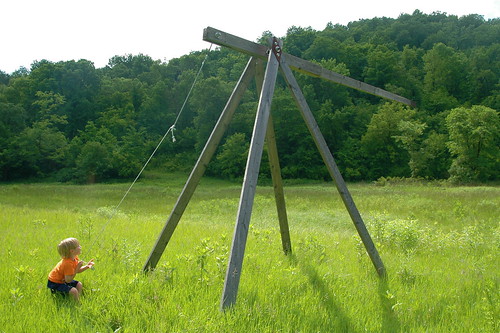recently, i hatched a plan to build a trebuchet with a merry band of co-conspirators, because who doesn’t love flinging things over long distances? and if you’re going to fling things over long distances, a trebuchet is definitely the way to go. i didn’t want not some wimpy tabletop trebuchet – no i wanted something with more oomph, maybe even one that could launch flaming pianos.
imagine my surprise when i discovered that there was one in the area that was made a few years ago by an enterprising 8th grader for a school project. after a quick phone call, i learned we could use it if it met our needs, and so odin and i went on hunt for a trebuchet nestled in a local valley ( pro tip: it is not difficult to convince an almost 5 year old to go on a hunt to find something that can fling heavy things over long distances ).
it is, i think, sufficiently awesome for the task at hand.
odin is pulling on the part of the arm that holds the counterweight. the opposite end is the throwing arm which needs a rope and sling attached before we can get down to business.
trebuchet rules of thumb: the counterweight should be about 100 times heavier than projectile and the sling should be slightly shorter than the the throwing arm.
yeesh, so if we’re going to chuch a 5 pound watermelon, we need a 500 pound counteweight! i’ll admit that i’m still a little unclear on how to build a proper sling – it sounds tricky:
"Our troop has learnt that the difficulty of a trebuchet isn’t in the construction, but in the fine adjustment of the sling to get the right release point. The drawing above shows how the sling whips around, and then SLIDES OFF THE END OF THE TREBUCHET ARM. You want the projectile (water balloon, rotten potato, flour bomb etc.) to fly out of the trebuchet when the angle of the arm is close to 45 degrees."
